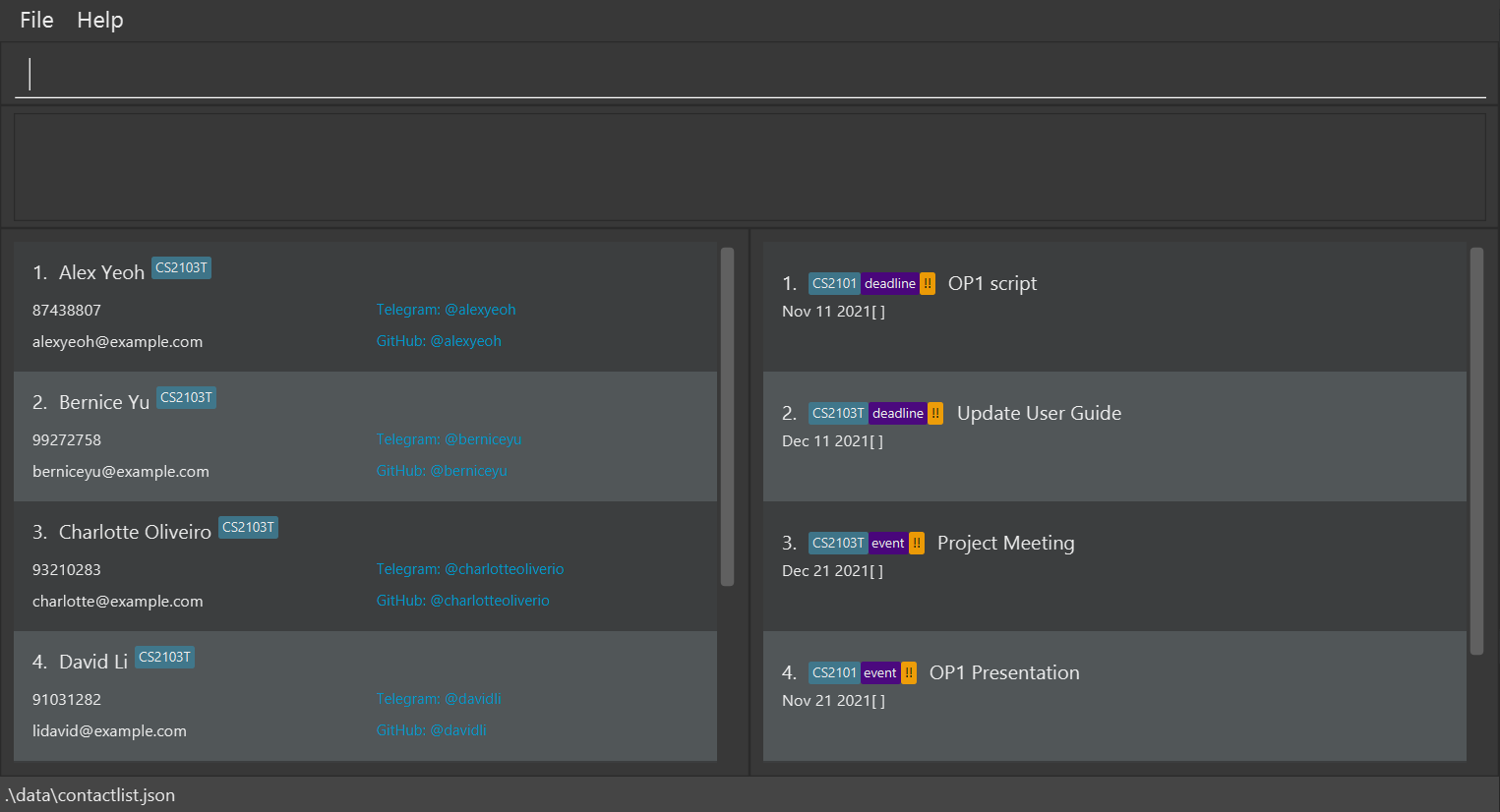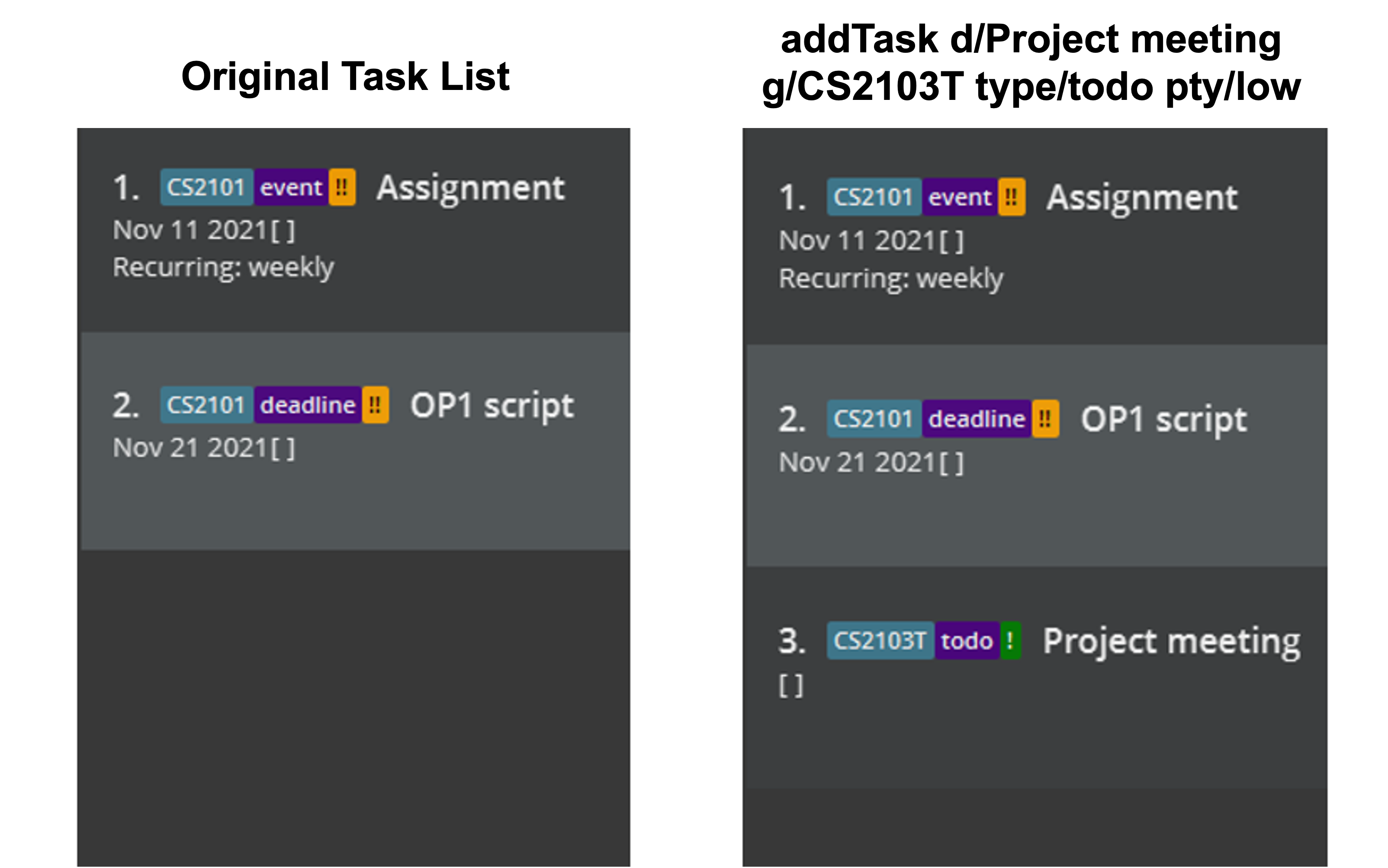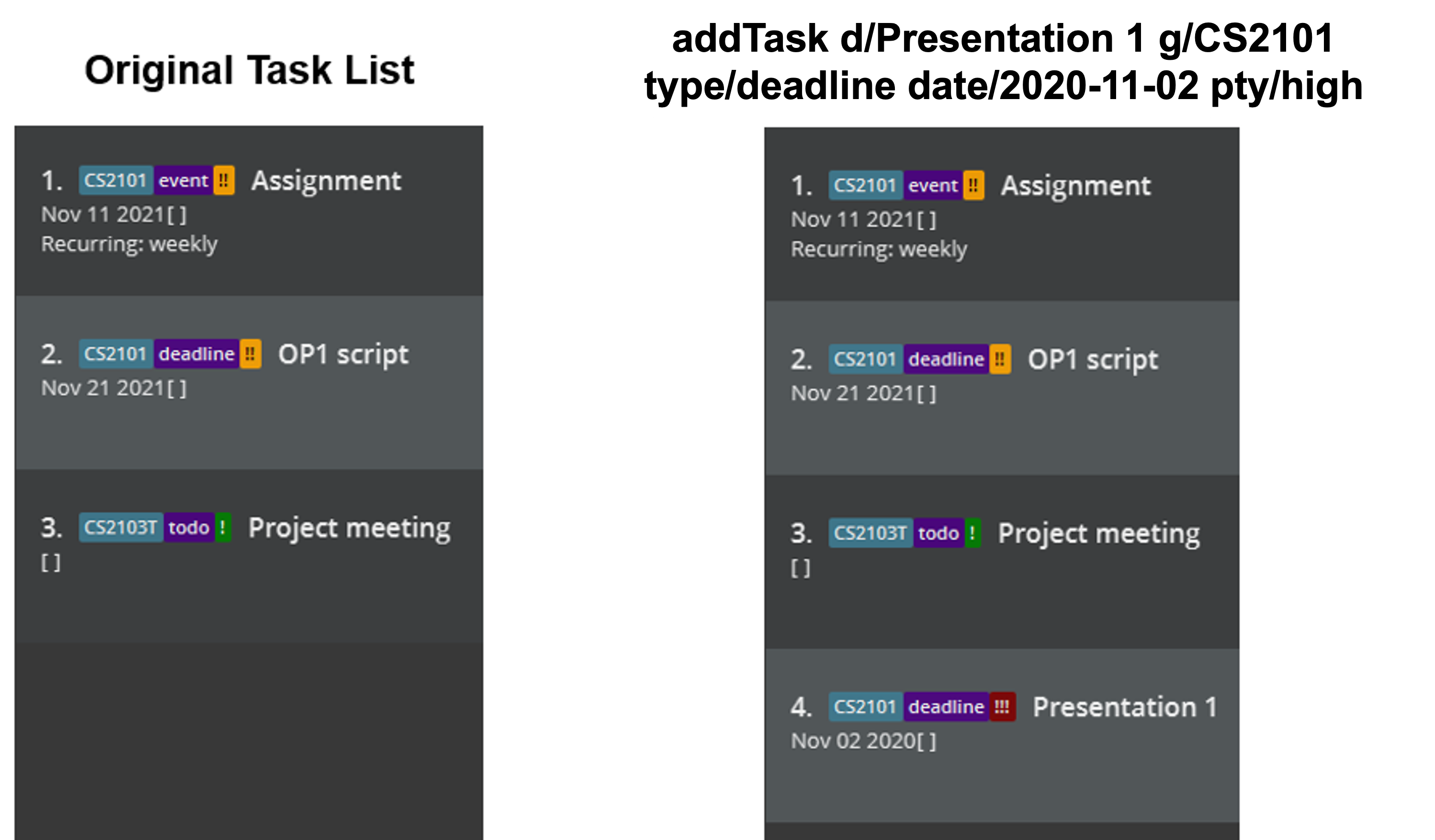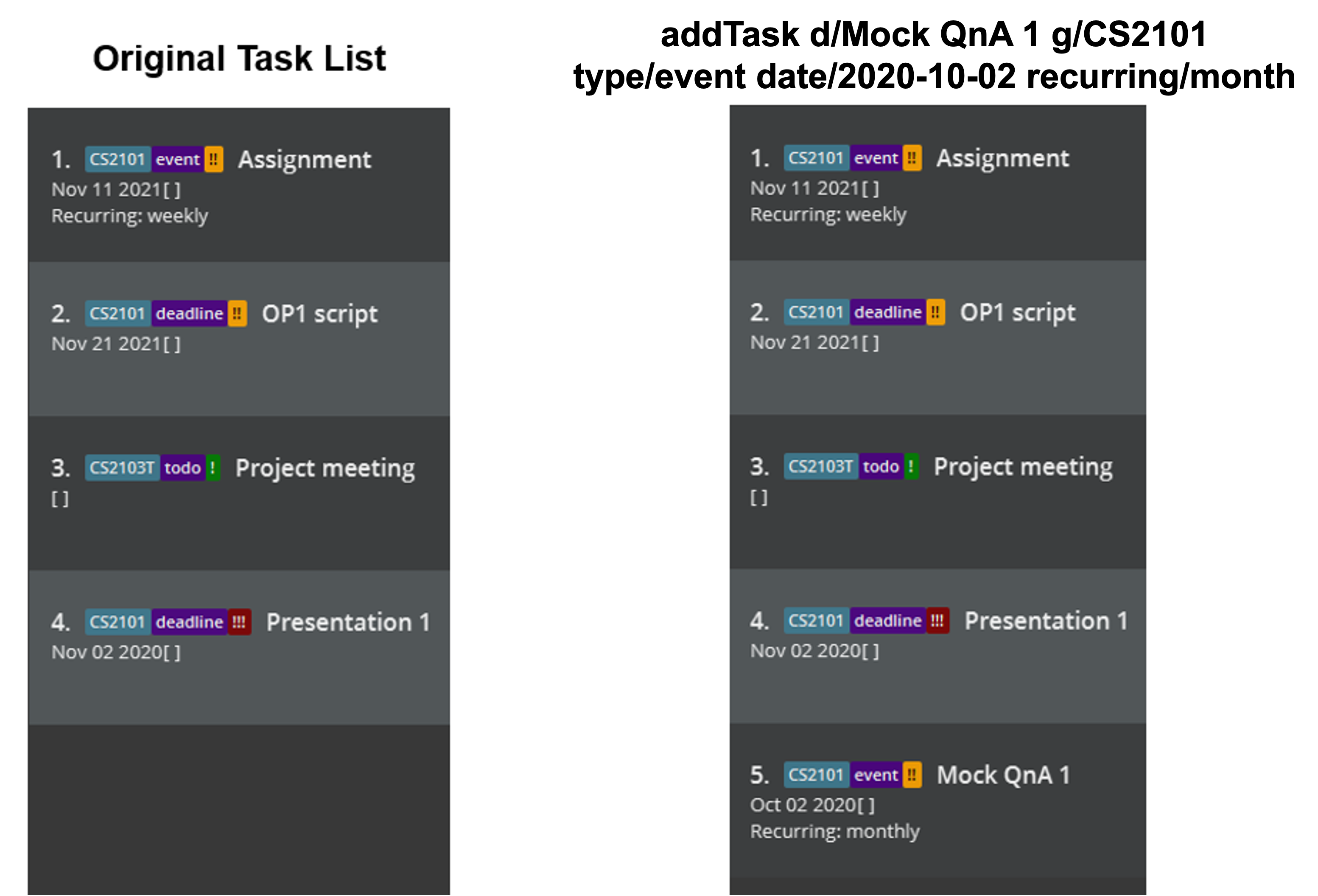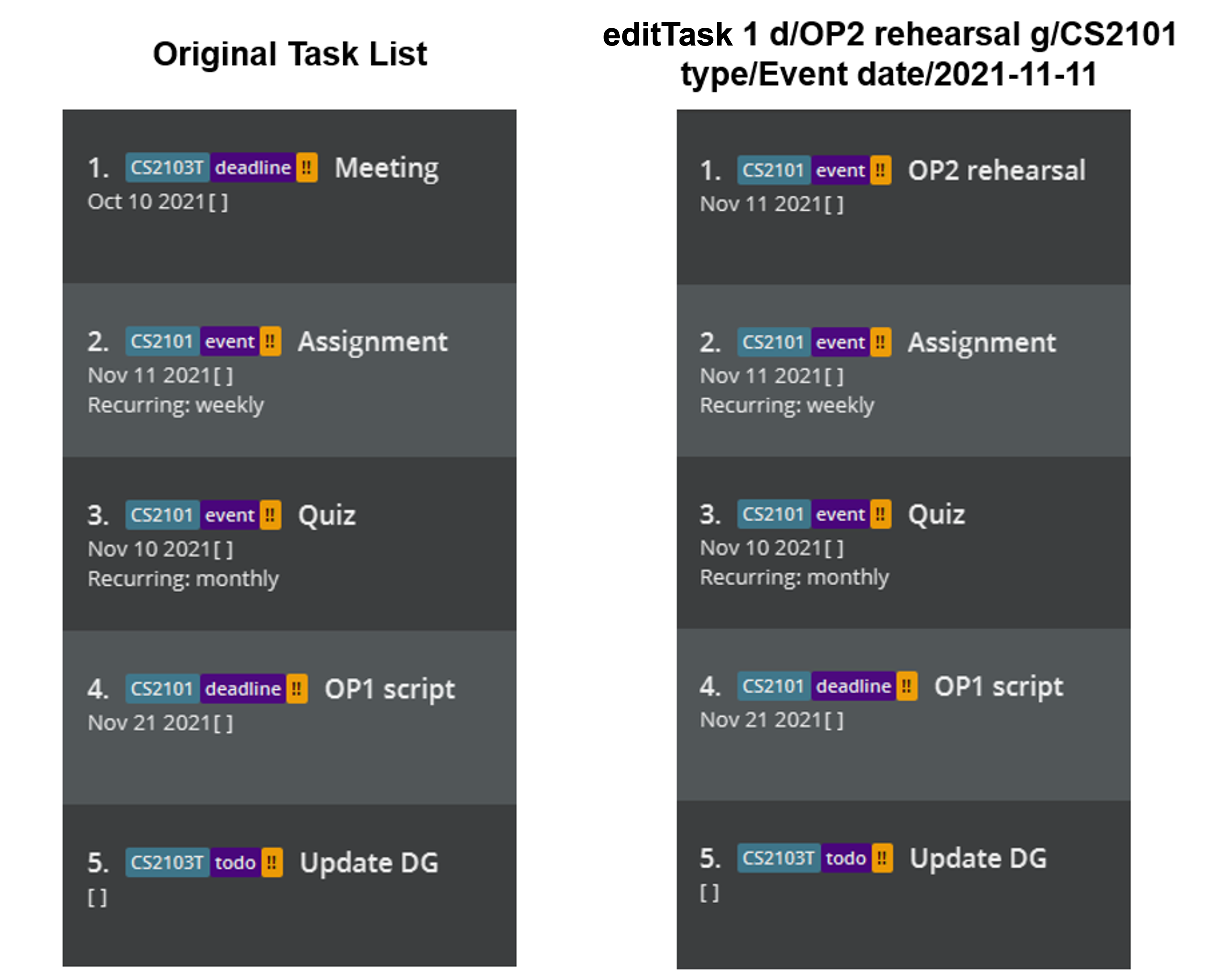User Guide
SWEe-book is a desktop app for CS2103T/CS2101 Computer Science students to manage contacts and tasks
pertaining to CS2103T/CS2101 module, optimized for use via a Command Line Interface (CLI). This means that you can operate
the application by typing commands into a Command Box. If you can type fast, SWEe-book can get your contact management and
task management done faster than traditional Graphical User Interface (GUI) applications,
which allows users to interact with the application through graphical icons such as buttons.
SWEe-book offers one-stop integration solution to managing tasks and contacts in your CS2103T or CS2101 group.
This SWEe-book User Guide will help you to:
- Manage your contacts
- Add/Delete/Edit your list of contacts
- Search through your contacts
- Group your contacts together by module
- Manage your tasks
- Add/Delete tasks
- Classify tasks as todos, deadlines, or events
- Mark your tasks as completed
- Filter/Sort tasks
Look into the first few sections to get started on using SWEe-book
Browse through the table of contents below to navigate through SWEe-book’s features and how to use them for a more efficient and convenient task and contact management!
- How to use SWEe-book User Guide
- Quick start
- UI Design
- Glossary
- Features
- FAQ
- Command summary
How to use SWEe-book User Guide
- The Quick Start section below will help you set up your SWEe-book
- Click here to dive straight to SWEe-book’s list of features
- Alternatively, you can click here to refer to the Command Summary Table
- You can also checkout a list of frequently asked questions (FAQs) here, and the SWEe-book’s glossary here!
Throughout SWEe-book User Guide,
![]() Notes are there to give you extra information about SWEe-book’s features.
Notes are there to give you extra information about SWEe-book’s features.
We hope that this user guide will be useful to you in using SWEe-book!
Quick start
-
Ensure you have Java
11or above installed in your Computer. -
Download the latest
SWEe-book.jarfrom here. -
Copy the file to the folder you want to use as the home folder for your SWEe-book.
-
Double-click the file to start the app. The GUI similar to the below should appear in a few seconds. Note how the app contains some sample data.
-
Type the command in the command box and press Enter to execute it. e.g. typing
helpand pressing Enter will open the help window.
Some example commands you can try:
-
list: Lists all contacts. -
addn/John Doe g/CS2103T p/98765432 e/johnd@example.com tg/johndoe gh/johndoe: Adds a contact namedJohn Doeto the SWEe-book. -
listTasks: Lists all tasks. -
deleteTask1: Deletes the first task shown in the current task list. -
exit: Exits the app.
- Refer to the Features below for details of each command.
![]() Tip:
Tip:
- If you are unsure about where the contact list, task list or command input box are, check out the Ui Design section.
UI Design

-
Command Input Box: Type your commands here!
-
Message Box: Displays the details of the result of your commands or error messages.
-
Contact List: Displays your list of group mates and their relevant information.
-
Task List: Displays your tasks.
Glossary
-
GUI is short-form for Graphical User Interface, which refers to what the user sees as a graphic. In SWEe-book, the GUI refers to the contact and task lists as shown in the red box below.

-
CLI is short-form for Command Line Interface, it is what the user types commands into to query or add information into SWEe-book. It refers to the box at the top which users type into (also known as the command box) and the box directly below it which shows feedback based on what command was typed. They are shown in the coloured boxes below.

-
Tasks are items which you would like to keep track of with a description attached to them. The task list is displayed on the right side of the GUI. There are three different types of tasks: a todo, deadline, or an event. A todo is a task that can be date-less (e.g. buy stationary) while a deadline and an event must be accompanied by a date.
-
Contacts are items which signify persons who you would like to keep a contact of. The contact list displayed on the left side of the GUI.
-
Commands are what the user types into the command box. They consist of the command keyword (e.g.
add,find,addTask)and the parameters to the command. Explanation of parameters is shown below. -
Parameters are the terms that the user types after the command keyword to narrow the scope of their query. There can any number of parameters to a command, even 0, depending on the command. An example of parameters is in the command format
add n/NAME g/GROUP1 [g/GROUP2] p/PHONE_NUMBER e/EMAIL tg/TELEGRAM_USERNAME gh/GITHUB_USERNAME,(n/NAME,g/GROUP1,[g/GROUP2],p/PHONE_NUMBER,e/EMAIL,tg/TELEGRAM_USERNAME,gh/GITHUB_USERNAME) are all parameters. Do note parameters in square brackets ([g/GROUP2]) are optional. -
Do note that any highlighted words (e.g.
add) in this User Guide refers to words that can be typed into the command box, or items that will show up in the GUI as a result. -
INDEX refers to a number which corresponds to a task’s/contact’s position in the task list/contact list. (e.g. INDEX 1 means it’s the first task on the task list)
-
Lexicographical order is an order similar to alphabetical order, but more relevant to programming and is more comprehensive. Just like how “a, b, c” is in alphabetical order, “0, 1, A, B, a, b” is in lexicographical order. Notice how the numbers come before upper case letters, which in turn come before lower case letters.
Features
General Features
Viewing help : help
Shows a window that allows you to copy the website link to access the user guide in cases when error messages are still insufficient.

Format: help
Exiting the program : exit
Exits the program.
Format: exit
Editing the data file
SWEe-book contacts data are saved as a JSON file [JAR file location]/data/contactlist.json, whereas tasks management data are saved as [JAR file location]/data/taskrecords.json. Advanced users are welcome to update data directly by editing the data files.
Saving the data
SWEe-book data are saved in the hard disk automatically after any command that changes the data. You do not need to save manually.
Contact Management Features
Adding a person: add
Adds a person to SWEe-book.
Format: add n/NAME g/GROUP1 [g/GROUP2] p/PHONE_NUMBER e/EMAIL tg/TELEGRAM_USERNAME gh/GITHUB_USERNAME
@johndoe and johndoe are equivalent as they will both be parsed into the username johndoe)
Examples:
-
add n/John Doe g/CS2103T p/98765432 e/johnd@example.com tg/@johndoe gh/johndoe- Adds a contact with name
John Doe, groupCS2103T, phone number98765432, emailjohnd@example.com, telegram usernamejohndoe, github usernamejohndoe
- Adds a contact with name
-
add n/Betsy Crowe p/92221234 g/CS2103T g/CS2101 e/betsycrowe@example.com tg/betsyyy gh/crowebetsy- Adds a contact with name
Betsy Crowe, groupCS2103TandCS2101, phone number92221234, emailbetsycrowe@example.com, telegram usernamebetsyyy, github usernamecrowebetsy
- Adds a contact with name
Listing all persons : list
Shows a list of all persons in SWEe-book.
Format: list
Locating persons by name: find
Finds persons whose names contain any of the given keywords.
Format: find KEYWORD [MORE_KEYWORDS]
- The search is case-insensitive. e.g.
hanswill matchHans - The order of the keywords does not matter. e.g.
Hans Bowill matchBo Hans - Only the name is searched.
- Only full words will be matched e.g.
Hanwill not matchHans - Persons matching at least one keyword will be returned (i.e.
ORsearch). e.g.Hans Bowill returnHans Gruber,Bo Yang
Examples:
-
find alex- Returns
Alex Yeoh
- Returns

-
find alex david- Returns
Alex Yeoh,David Li
- Returns
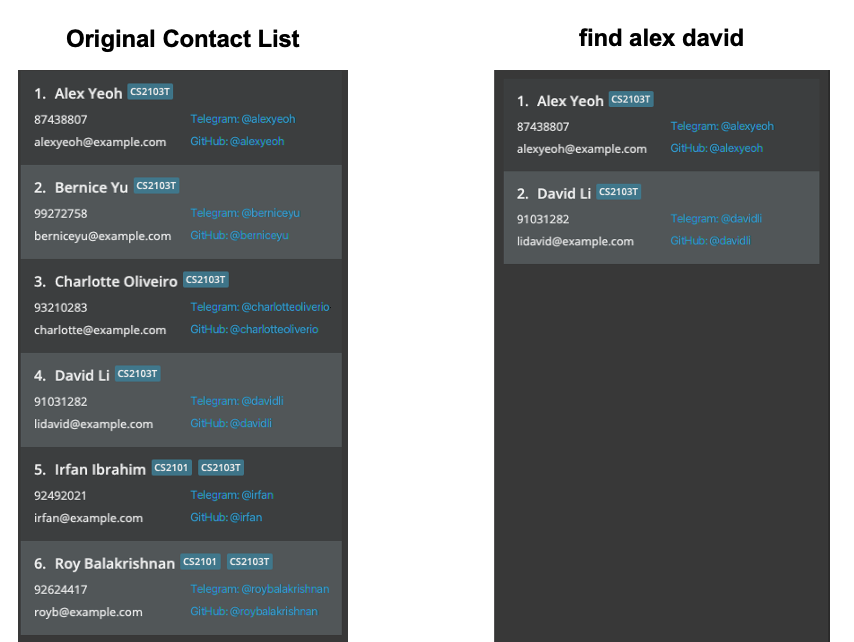
Editing a person : edit
Edits an existing person in SWEe-book.
Format: edit INDEX [n/NAME] [g/GROUP1] [g/GROUP2] [p/PHONE] [e/EMAIL] [tg/TELEGRAM] [gh/GITHUB]
- Edits the person at the specified
INDEX. The index refers to the index number shown in the displayed person list. The index must be a positive integer 1, 2, 3, … - At least one of the optional fields must be provided.
- Existing values will be updated to the input values.
Examples:
-
edit 1 p/91234567 e/johndoe@example.com- Edits the phone number and email address of the 1st person to be
91234567andjohndoe@example.comrespectively.
- Edits the phone number and email address of the 1st person to be
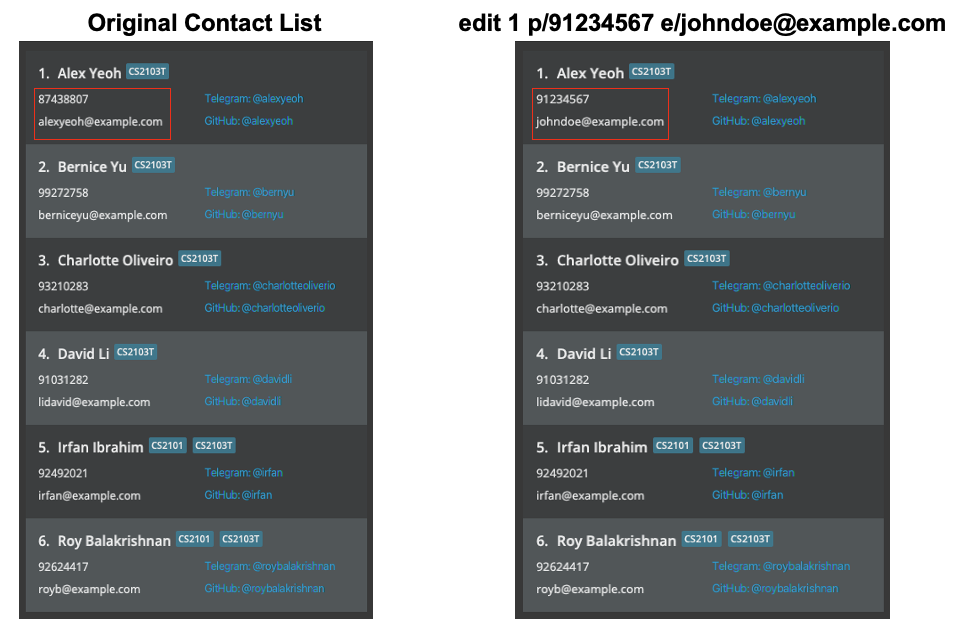
-
find Bernicefollowed byedit 1 tg/bernyu gh/bernyu- Edits the telegram and github usernames of the 1st person in the results of the
findcommand.
- Edits the telegram and github usernames of the 1st person in the results of the
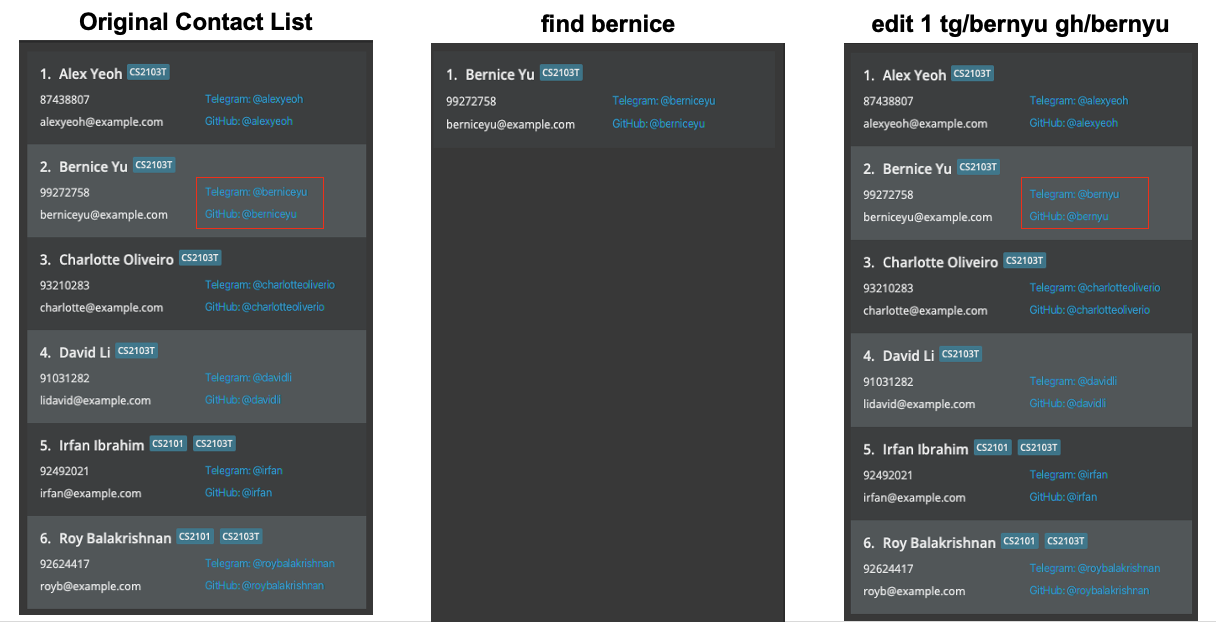
Deleting a person : delete
Deletes the specified person from SWEe-book.
Format: delete INDEX
- Deletes the person at the specified
INDEX. - The index refers to the index number shown in the displayed person list.
- The index must be a positive integer 1, 2, 3, …
Examples:
-
listfollowed bydelete 2- Deletes the 2nd person in SWEe-book.
-
find Betsyfollowed bydelete 1- Deletes the 1st person in the results of the
findcommand.
- Deletes the 1st person in the results of the
Filtering persons by a specified group: group
Retrieves the list of people that are in the specified group.
Format: group GROUP_NAME
-
GROUP_NAMErefers to one of the 2 groups: CS2101 or CS2103T. -
GROUP_NAMEis case-insensitive. - Note that this is not a strict filter (i.e
group CS2103Tcan return a person who is from both CS2103T and CS2101 groups)
Examples:
-
group CS2101- Returns people in CS2101
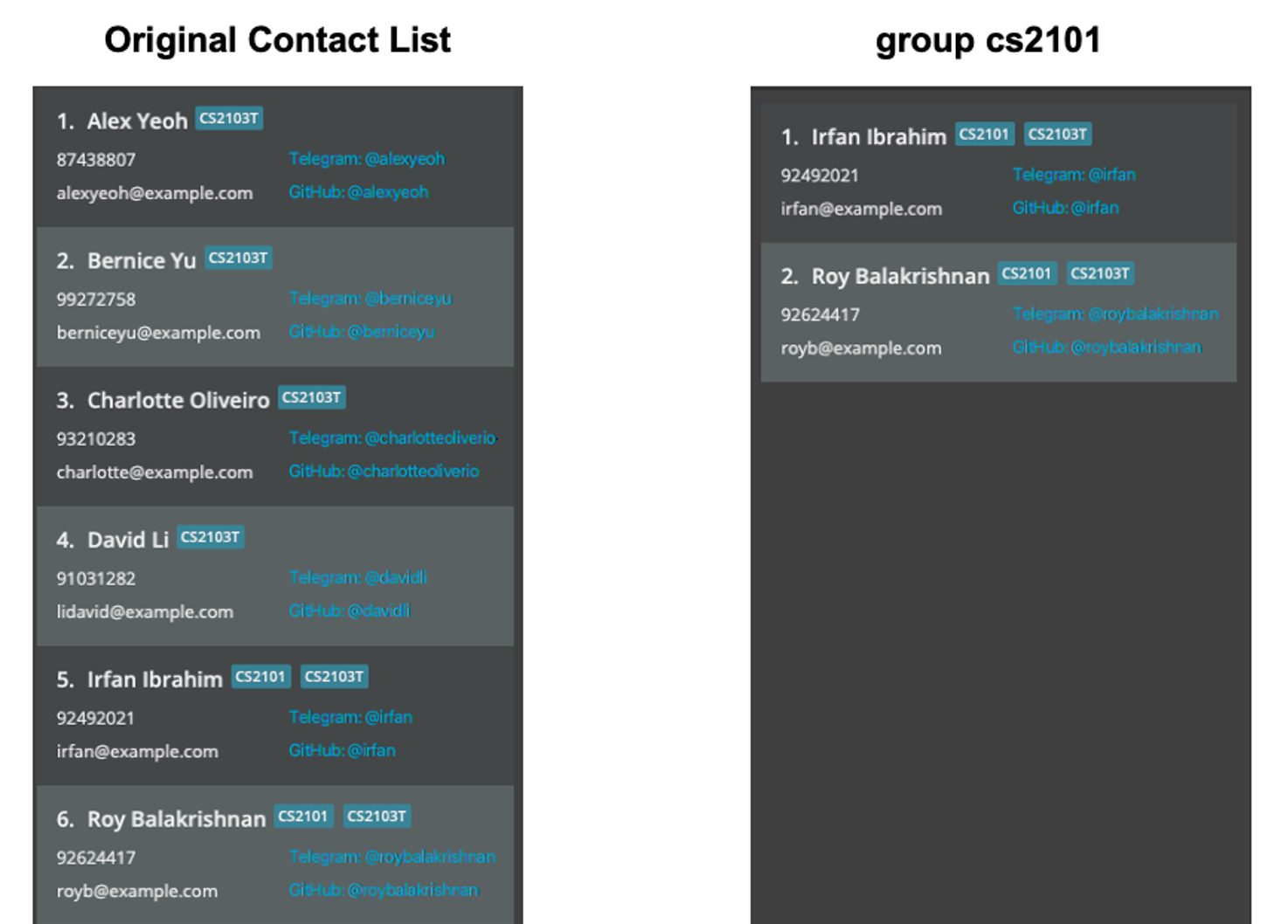
-
group CS2103T- Returns people in CS2103T
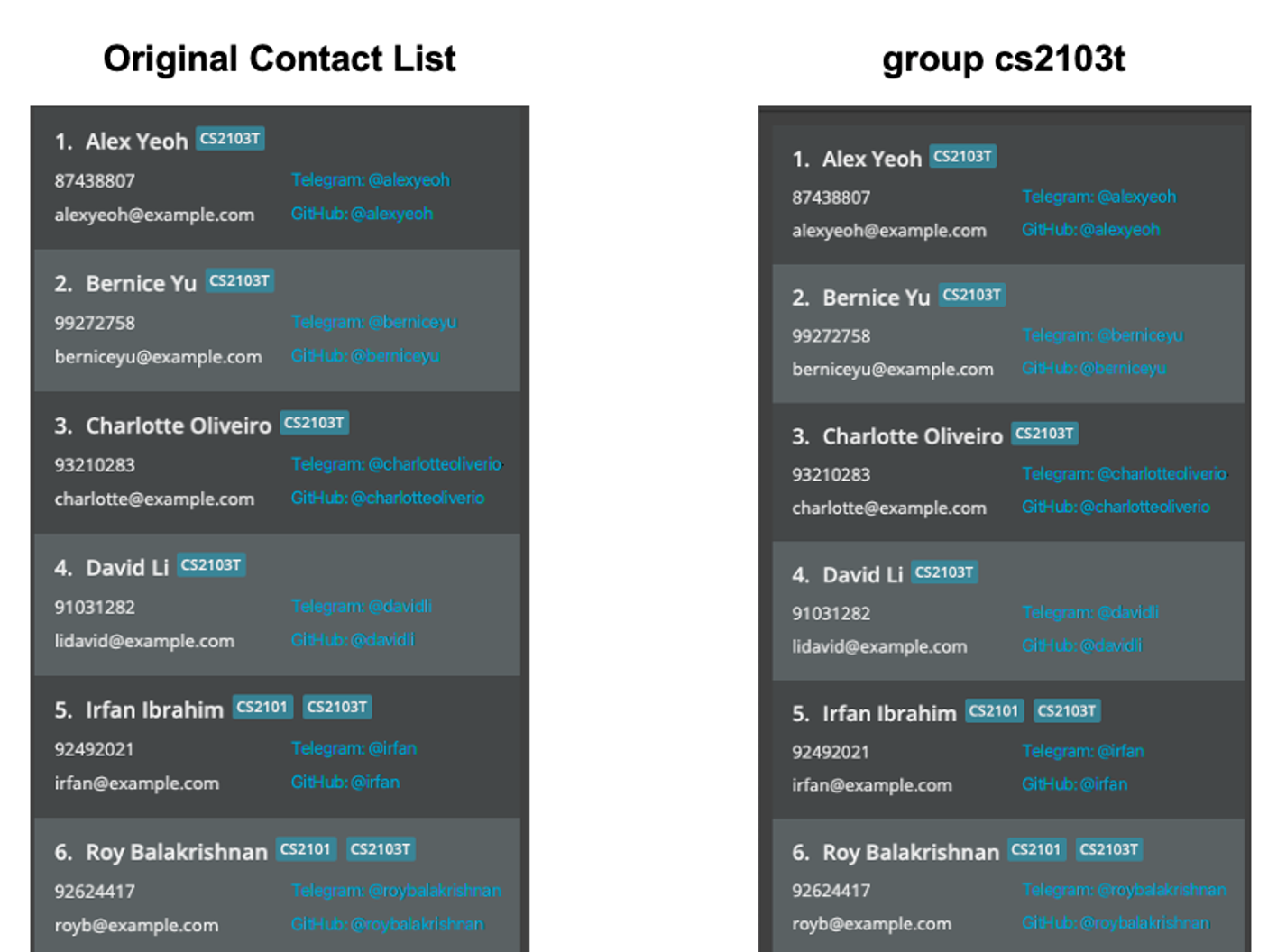
Clearing all contact entries : clear
Clears all contact entries from SWEe-book.
Format: clear
Task Management Features
Adding a Task : addTask
Adds a new task to SWEe-book.
Format: addTask d/DESCRIPTION g/GROUP type/TYPE [date/DATE] [pty/PRIORITY] [recurring/RECURRING_FREQUENCY]
-
GROUPrefers to one of the 2 groups:CS2101orCS2103T -
TYPErefers to one of the 3 types of tasks:todo,eventordeadline -
DATEis in YYYY-MM-DD format and is only needed for events or deadlines (i.e.DATEis optional for Todo tasks) -
PRIORITYrefers to one of the 3 levels of priorities / importance of the task:low,med(default) orhigh -
RECURRING_FREQUENCYrefers to one of the 3 different frequencies that the task could occur:week,monthoryear(whereweekmeans that the task is recurring weekly)- Any Task that has a recurring frequency must have a date as well, for example a Todo with recurring frequency must have a date.
- If a Task has a recurring frequency and its date is initialised to be in the last week/month/year, it will be set to the current week/month/year in the next boot up of the application. Examples:
-
addTask d/Project meeting g/CS2103T type/todo pty/low- Add a non-recurring
todowith no date andlowpriority and task descriptionProject meetingto the groupCS2103T
- Add a non-recurring
-
addTask d/Presentation 1 g/CS2101 type/deadline date/2020-11-02 pty/high- Add a non-recurring
deadlinedue on2020-11-02withhighpriority and task descriptionPresentation 1to the groupCS2101
- Add a non-recurring
-
addTask d/Mock QnA 1 g/CS2101 type/event date/2020-10-02 recurring/month- Add a
eventthat recurs everymonthwith date2020-10-02and defaultmedpriority and task descriptionMock QnAto the groupCS2101
- Add a
Editing a task: editTask
Edits an existing task in the task list.
Format: editTask INDEX [d/DESCRIPTION] [g/GROUP] [type/TYPE] [date/DATE] [pty/PRIORITY] [recurring/RECURRING_FREQUENCY]
- Edits the task at the specified
INDEX. The index refers to the index number shown in the displayed task list. The index must be a positive integer 1, 2, 3, … - At least one of the optional fields must be provided.
- Existing values will be updated to the input values.
- To set a recurring task to be non-recurring, you can specify
recurring/noneas one of the arguments.
Examples:
-
editTask 1 d/OP2 rehearsal g/CS2101 type/Event date/2021-11-11- Edits the description, group, type of task, date of the first task in the task list to be
OP2 rehearsal,CS2101,Eventand2021-11-11respectively.
- Edits the description, group, type of task, date of the first task in the task list to be
Deleting a task: deleteTask
Format: deleteTask INDEX
Deletes the task at the specified INDEX.
- The index refers to the index number shown in the displayed task list.
- The index must be a positive integer 1, 2, 3, …
Examples:
-
deleteTask 1- Deletes the 1st task in the task list.
Marking a task as done: doneTask
Format: doneTask INDEX
Marks the task at the specified INDEX as done.
- The index refers to the index number shown in the displayed task list.
- The index must be a positive integer 1, 2, 3, …
- The task must not have been marked as done before.
Examples:
-
doneTask 1- Marks the 1st task in the task list as done.
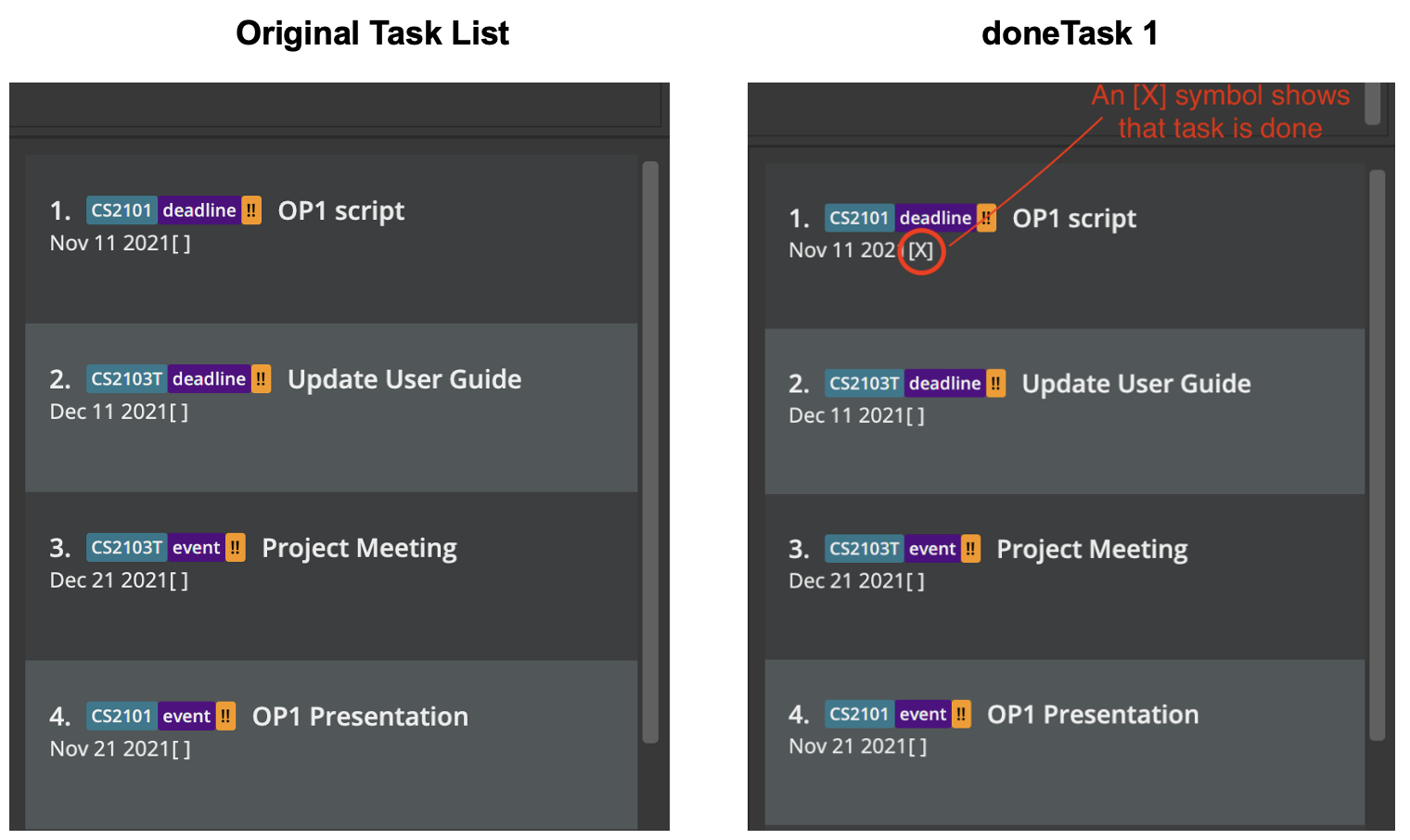
Sorting tasks: sortTasks
Sort tasks based on their descriptions, groups, priorities or deadlines / event dates.
Format: sortTasks param/PARAMETER o/ORDER
- The sort is case-insensitive. e.g. CS2103T will be lexicographically identical to cs2103t, but cs2101 still comes before CS2103T.
-
PARAMETERincludesdesc(for description),date(for a deadline / date of event),pty(for priority) andgroup. -
ORDERincludesafor ascending order (0-9 and A-Z, oldest to newest, lowest to highest priority) anddfor descending order(Z-A and 9-0, newest to oldest, highest to lowest priority) - When the tasks are sorted by
date, date-lessTodotasks will always be at the bottom of the list.
Examples:
-
sortTasks param/pty o/a- Sorts the task list by priority, with the low-priority tasks at the top and high-priority tasks at the bottom
-
sortTasks param/group o/a- Sorts the task list by group, with CS2101 tasks at the top and CS2103T tasks at the bottom
-
sortTasks param/desc o/d- Sorts the task list by description, with the tasks that has description which starts with “Z” at the top, then “Y”, and so on.
-
sortTasks param/date o/a- Sorts the task list in chronological order (in terms of their deadlines / event dates)
-
sortTasks param/date o/d- Sorts the task list in reverse chronological order (in terms of their deadlines / event dates)
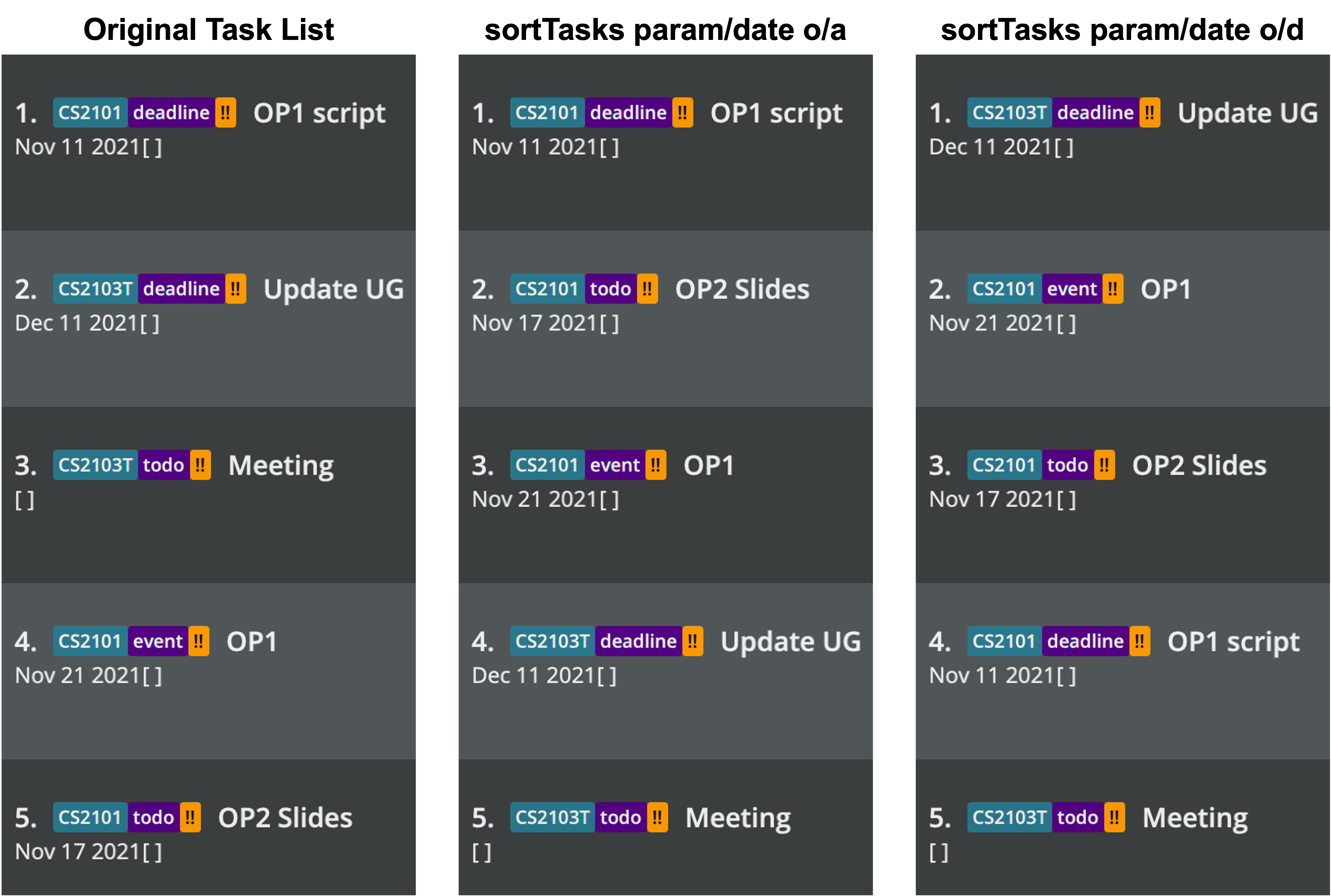
Filtering tasks by modules: filterTasks
Filter tasks based on a criterion
Format: filterTasks FILTER_CRITERION
- Filters the task by the specified
FILTER_CRITERION -
FILTER_CRITERIONrefers to eitherg/GROUP,date/DATE,type/TASKTYPE,d/DESCRIPTIONorpty/PRIORITY - FilterTasks only accepts 1
FILTER_CRITERIONand not more. - Tasks corresponding to the criterion specified will be shown
Examples:
-
filterTasks g/CS2101- Shows all the tasks related to CS2101 group
-
filterTasks date/2021-11-21- Shows all the tasks with the date of 21 Nov 2021
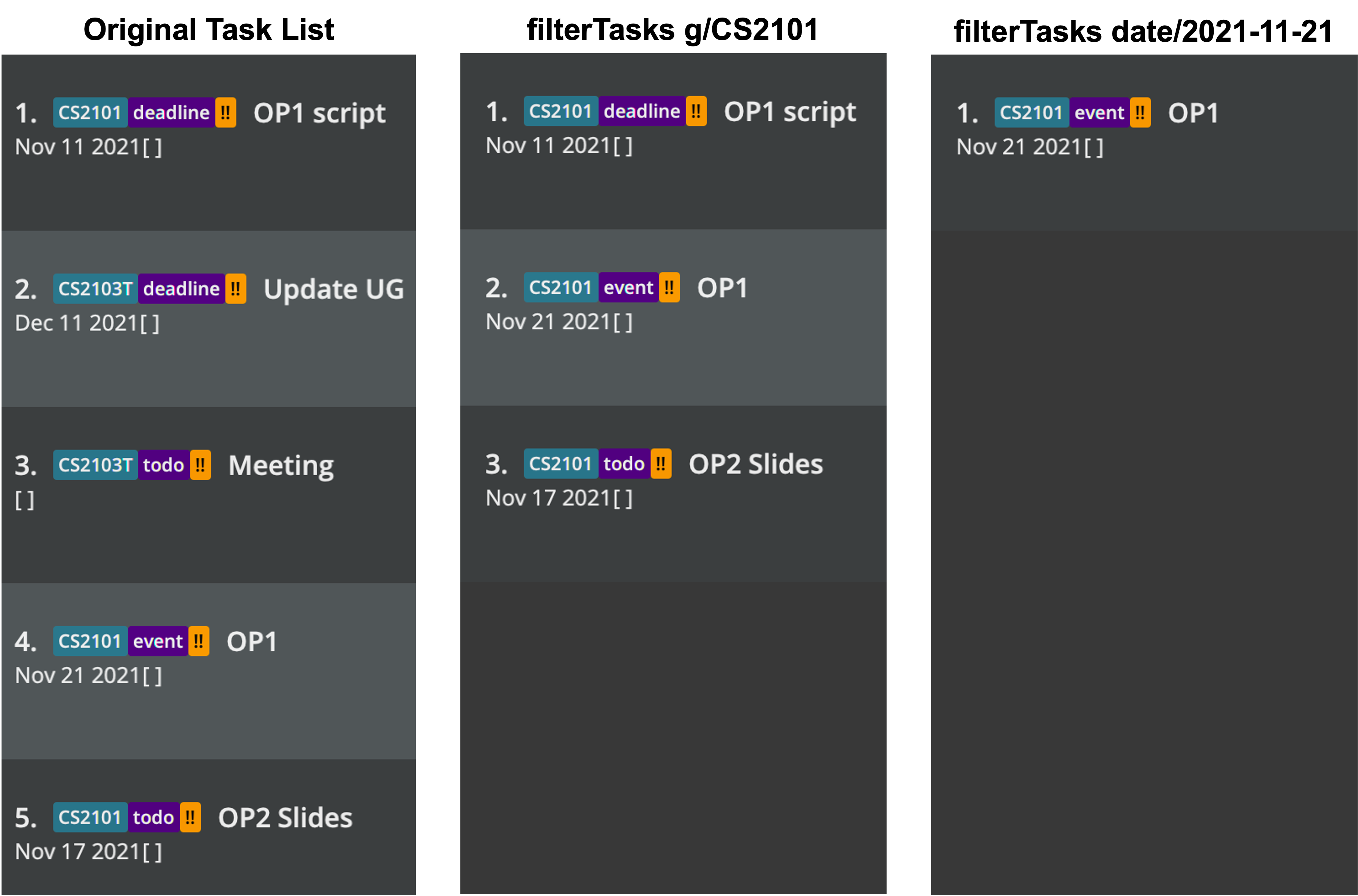
Listing all tasks: listTasks
Shows a list of all tasks in SWEe-book.
Format: listTasks
- Lists all tasks, resetting any sorting and filtering done by you previously
Examples:
-
listTasks- Displays all tasks in right half of the GUI
FAQ
Q: How do I transfer my data to another Computer?
A: You can install the app in the other computer and overwrite the empty data file it creates with the file that contains the data of your previous SWEe-book home folder.
Q: How do I install Java 11 on my computer?
A: You can install Java 11 by downloading it here.
Q: How can I ensure that Java 11 has been installed on my computer?
A: Open up your terminal and key in java --version. You can then see the java version that has been installed. An output of “java 11” means that java 11 has been successfully installed.
Q: Can I sync my contacts and tasks with other devices?
A: Unfortunately, you cannot sync them at the moment. However, please look out for future updates.
Command summary
Here, you can view the summary of general, contact management, and task management commands.
General Commands
| Action | Format, Examples |
|---|---|
| Help | help |
| Exit | exit |
Contact Management Commands
| Action | Format, Examples |
|---|---|
| Add |
add n/NAME g/GROUP1 [g/GROUP2] p/PHONE_NUMBER e/EMAIL tg/TELEGRAM_USERNAME gh/GITHUB_USERNAME e.g., add n/John Doe g/CS2103T p/98765432 e/johnd@example.com tg/@johndoe gh/johndoe
|
| Clear | clear |
| Delete |
delete INDEXe.g., delete 3
|
| Edit |
edit INDEX [n/NAME] [g/GROUP1] [g/GROUP2] [p/PHONE] [e/EMAIL] [tg/TELEGRAM] [gh/GITHUB]e.g., edit 2 n/James Lee e/jameslee@example.com
|
| Find |
find KEYWORD [MORE_KEYWORDS]e.g., find James Jake
|
| Group |
group GROUP e.g., group CS2103T
|
| List | list |
Task Management Commands
| Action | Format, Examples |
|---|---|
| Add Task |
addTask d/DESCRIPTION g/GROUP type/TYPE [date/DATE] [pty/PRIORITY] [recurring/RECURRING_FREQUENCY] (do note that DATE is only optional for Todo tasks) |
| Edit Task | editTask INDEX [d/DESCRIPTION] [g/GROUP] [type/TYPE] [date/DATE] [pty/PRIORITY] [recurring/RECURRING_FREQUENCY] |
| Delete Task | deleteTask INDEX |
| Done Task | doneTask INDEX |
| Sort Tasks |
sortTasks p/PARAMETER o/ORDER e.g., sortTasks p/desc o/1
|
| Filter Tasks |
filterTasks FILTER_CRITERION e.g., filterTasks g/CS2101
|
| List Tasks | listTasks |
